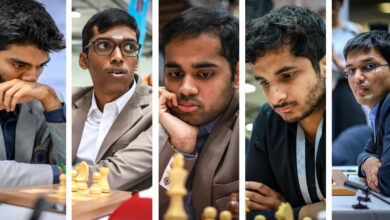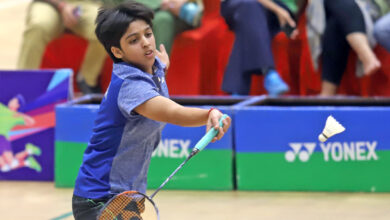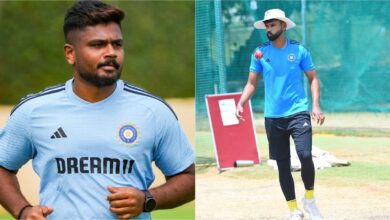Is it time for India’s top table tennis players Manika Batra and Sreeja Akula to revisit the long-pimple rubber game plan? | Sport-others News

Before the Olympics, rubbers on the racket were the talk of the table tennis world especially after India’s Ayhika Mukherjee, Sreeja Akula and Manika Batra had stunned China’s top paddlers.Reportedly, China had a camp on how to play against those using pimple rubber.
In the Olympic singles competition, Sreeja put up a solid fight against Sun Yingsha, the silver medal from Tokyo, in a pre-quarter final clash. She squandered nine game points in the first two games and couldn’t recover after that. Manika was looking geared up for the team event after her loss to Japan’s Miu Hirano in singles.
India’s opponents in the quarterfinal were Germany. But whoever thought that Germany’s Annett Kaufmann would end India’s Paris sojourn.
The left-hander read Manika’s game so well that no amount of twiddles or blocks could unsettle her. Kaufmann won 3-1 and then inflicted an even worse 3-0 defeat on Sreeja in what was the final match of the tie. Both Sreeja and Manika use long-pimple rubber on one side of their rackets.
Long-pimple rubber is a defensive ploy and puts the opposite effect on the spin that the opponent plays. If the opponent plays a backspin shot, when one returns with this rubber, the ball will have topspin and vice-versa. A quick switch mid-rally is the key to surprising the opponent.
However, the ‘long pimple’ advantage vanished for India’s players during the Olympics. With pace, power and just understanding how the long pimples work, Kaufmann was able to defeat two Indian players, perhaps the best in the world at making the use of long-pimple rubber.
The Los Angeles Olympics is four years away but what does a Manika or Sreeja — both top 25 players — need to do to have a shot at a medal?
Manika’s coach Aman Balgu says the focus should be fitness levels.
“I feel that Manika and other Indians have to work on their fitness levels. In order to win an Olympic medal, we need to be able to generate much more power and spin. You need to win six matches to win a medal in singles and I don’t think that right now our players will be able to keep the same high intensity for six straight matches. We can talk about strategies and tactics all day long, but if you don’t have the physical fitness to back it, you won’t get a medal,” Balgu said.
National coach Massimo Costantini, who’s currently in his hometown in Italy on a mini-break before the Ultimate Table Tennis (UTT) League starts next week, told The Indian Express that it doesn’t matter which rubber a player uses. What matters is how one can vary their strokes.
“In the women’s game, the focus is on variation and ball placement. I won’t say if pimple rubber is an advantage or not, but you can have more variations if you’re playing with pimples. No consecutive balls should be played the same way. You have to create a surprise, you can’t get into a predictable loop. The key should be a change of strategy, basically disorienting the opponents,” the 66-year-old Costantini said.
What is the option?
There’s no denying the fact that Indian women have reached the top 25 in the world because of their use of long pimples. After Sreeja and Manika, the next best-placed Indian is Sutirtha Mukherjee at World No.83, who uses fast rubbers on both sides of the bat. And the women who use fast rubbers have struggled to enter even the top 60 in the world with Archana Kamath being the best among them, reaching world No.65 in 2022.
Somnath Ghosh, Sreeja’s coach, says using pimples is not the only reason.
“Sreeja and Manika have not reached where they are because of long pimples, but with it. There’s a difference. Look, you can defend with long pimples but how will you get a point? You have to attack. And for that, you need to have a great forehand attack. You also need to know when to attack. That astuteness needs to be there,” Ghosh said.
But how does a Sreeja enter the top 10 rankings in the world?
“Sreeja’s graph has been impressive. She has entered the top 100 and reached World No.21 in less than two years. Now if you ask me what needs to improve to give her a medal in LA, I will only say fitness. Physical and mental,” Ghosh said.
The bigger picture
Coach Costantini reiterates that to reach the top, ‘you need a proper structure’.
“I’m confident that Indians can beat the top players irrespective of their rubbers. We have players with drive and skills but what we need is a solid programme and support. We need consent development of coaches who know the modern ways of the sport and how to develop a player. One of the main reasons I have joined here is to help create such a structure,” he says.
The first is setting up a national centre which will most likely come up in Bengaluru.
“It will change the sport in the country, I can tell you. We can have a permanent place to have this ‘Indian TT movement’. We can have opportunities for players at various levels to come and train. Talent identification will be massive and the players and coaches can be monitored. The country is ready to start producing players of the highest quality and this will just accelerate that,” Costantini.
What about the men?
With Sharath Kamal having played his last Olympics, the baton has fallen to Harmeet Desai and G Sathiyan. The two haven’t broken into the top 30 in the past three years, with Harmeet’s career-best being 59. Costantini, though, says he’s not worried about the men.
“I know that Indian men will climb new heights. Just look at the way Manav Thakkar is playing and mind you, there’s a huge pool of talent. Consency is a key area they have to focus on and we’re going to help them reach the top,” he says.
Two years ago, Indian paddlers had no medal hopes at the Olympics. That changed just before Paris. Come LA 2028, the call for a medal is only going to get louder, amplified the long pimples or not, is left to be seen.






